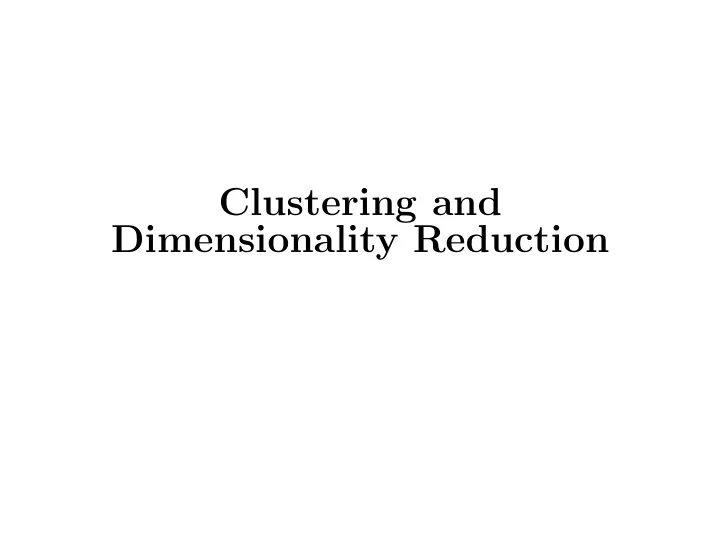

Clustering and Dimensionality Reduction
Preview • Clustering – K -means clustering – Mixture models – Hierarchical clustering • Dimensionality reduction – Principal component analysis – Multidimensional scaling – Isomap
Unsupervised Learning • Problem: Too much data! • Solution: Reduce it • Clustering: Reduce number of examples • Dimensionality reduction: Reduce number of dimensions
Clustering • Given set of examples • Divide them into subsets of “similar” examples • How to measure similarity? • How to evaluate quality of results?
K -Means Clustering • Pick random examples as initial means • Repeat until convergence: – Assign each example to nearest mean – New mean = Average of examples assigned to it
K -Means Works If . . . • Clusters are spherical • Clusters are well separated • Clusters are of similar volumes • Clusters have similar numbers of points
Mixture Models n c � P ( x ) = P ( c i ) P ( x | c i ) i =1 Objective function: Log likelihood of data Naive Bayes: P ( x | c i ) = � n d j =1 P ( x j | c i ) AutoClass: Naive Bayes with various x j models Mixture of Gaussians: P ( x | c i ) = Multivariate Gaussian In general: P ( x | c i ) can be any distribution
Mixtures of Gaussians p(x) x � � 2 � 1 − 1 � x − µ i P ( x | µ i ) = √ 2 πσ 2 exp 2 σ
The EM Algorithm Initialize parameters ignoring missing information Repeat until convergence: E step: Compute expected values of unobserved variables, assuming current parameter values M step: Compute new parameter values to maximize probability of data (observed & estimated) (Also: Initialize expected values ignoring missing info)
EM for Mixtures of Gaussians Initialization: Choose means at random, etc. E step: For all examples x k : P ( µ i | x k ) = P ( µ i ) P ( x k | µ i ) P ( µ i ) P ( x k | µ i ) = � P ( x k ) i ′ P ( µ i ′ ) P ( x k | µ i ′ ) M step: For all components c i : n e 1 � P ( c i ) = P ( µ i | x k ) n e k =1 � n e k =1 x k P ( µ i | x k ) = µ i � n e k =1 P ( µ i | x k ) k =1 ( x k − µ i ) 2 P ( µ i | x k ) � n e σ 2 = i � n e k =1 P ( µ i | x k )
Mixtures of Gaussians (cont.) • K-means clustering ≺ EM for mixtures of Gaussians • Mixtures of Gaussians ≺ Bayes nets • Also good for estimating joint distribution of continuous variables
Hierarchical Clustering • Agglomerative clustering – Start with one cluster per example – Merge two nearest clusters (Criteria: min, max, avg, mean distance) – Repeat until all one cluster – Output dendrogram • Divisive clustering – Start with all in one cluster – Split into two (e.g., by min-cut) – Etc.
Dimensionality Reduction • Given data points in d dimensions • Convert them to data points in r < d dimensions • With minimal loss of information
Principal Component Analysis Goal: Find r -dim projection that best preserves variance 1. Compute mean vector µ and covariance matrix Σ of original points 2. Compute eigenvectors and eigenvalues of Σ 3. Select top r eigenvectors 4. Project points onto subspace spanned by them: y = A ( x − µ ) where y is the new point, x is the old one, and the rows of A are the eigenvectors
Multidimensional Scaling Goal: Find projection that best preserves inter-point distances Point in d dimensions x i Corresponding point in r < d dimensions y i δ ij Distance between x i and x j d ij Distance between y i and y j � 2 � d ij − δ ij � • Define (e.g.) E ( y ) = δ ij i,j • Find y i ’s that minimize E by gradient descent • Invariant to translations, rotations and scalings
Isomap Goal: Find projection onto nonlinear manifold 1. Construct neighborhood graph G : For all x i , x j If distance( x i , x j ) < ǫ Then add edge ( x i , x j ) to G 2. Compute shortest distances along graph δ G ( x i , x j ) (e.g., by Floyd’s algorithm) 3. Apply multidimensional scaling to δ G ( x i , x j )
Summary • Clustering – K -means clustering – Mixture models – Hierarchical clustering • Dimensionality reduction – Principal component analysis – Multidimensional scaling – Isomap
Recommend
More recommend